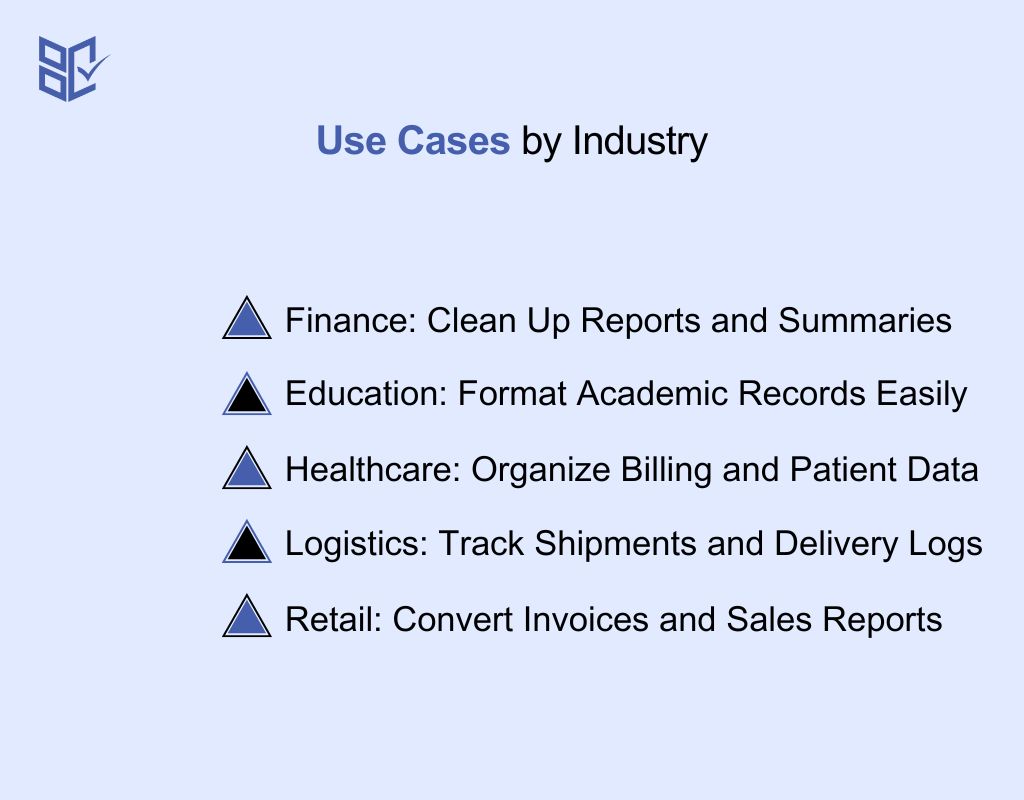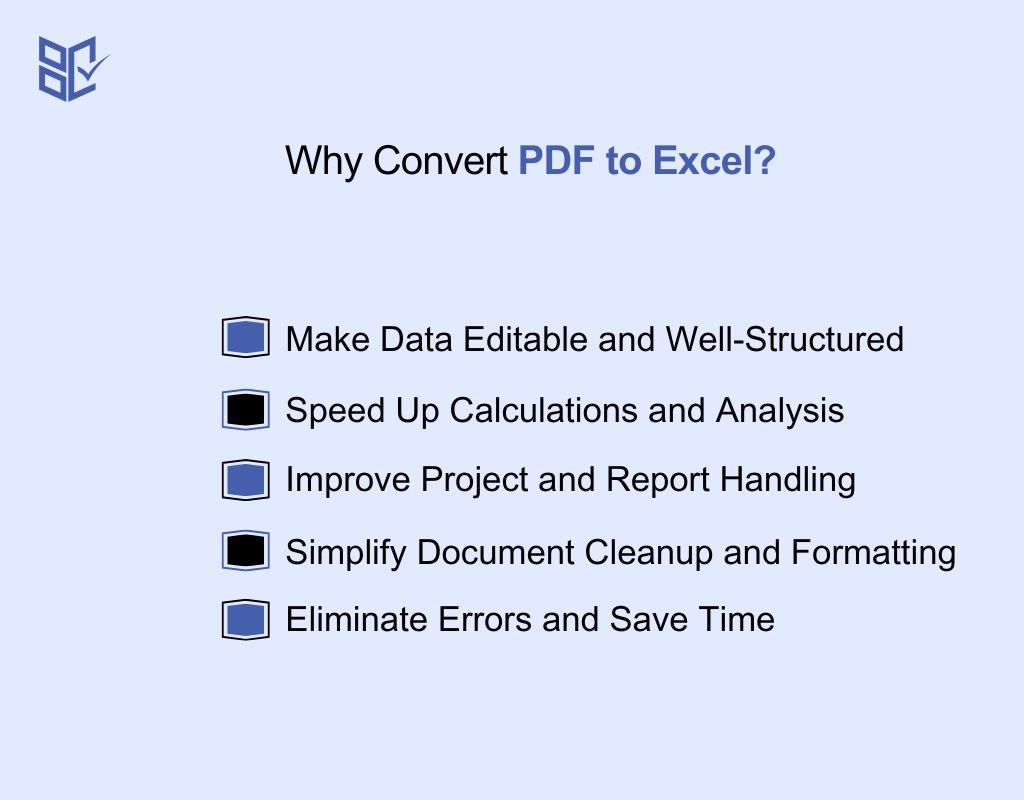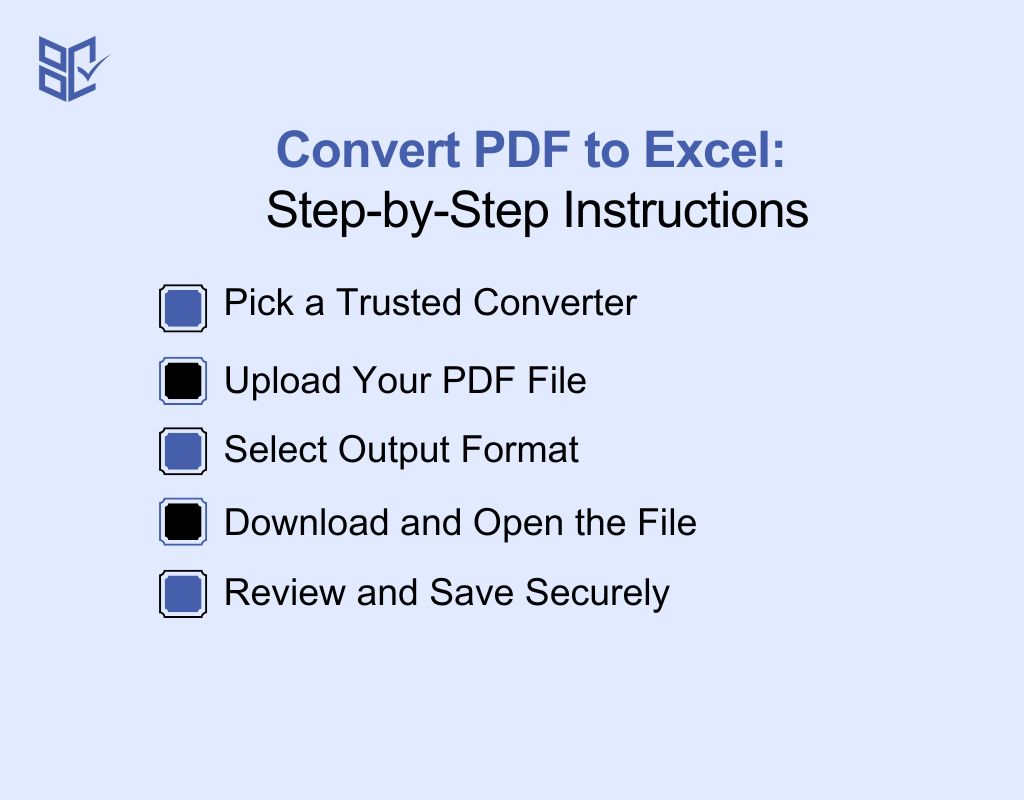Convert PDF to Excel
Convert PDF to Excel bank statement effortlessly while keeping data intact. Extract transactions, organize finances, and work with editable spreadsheets in seconds.
Add Your File
Drag & Drop Or Select File
Data security is our top priority
Bank Statement Converters prioritises the confidentiality and integrity of your data. As a testament to our commitment, we adhere to stringent compliance standards, including GDPR, SOC 2, and HIPAA. Privacy Policy



How to Convert PDF To Excel File Easily
Why Choose Our PDF to Excel converter?
Accessibility
Access our converter anytime—turn PDFs, reports, and tables into Microsoft Excel spreadsheets instantly without downloads or complex OCR tools.
Affordable Plans for Everyone
Affordable Plans for Everyone tailored to meet diverse needs without breaking the bank, offering flexibility and value for all.
Starter
$90 / month
Save 10% annually
Why should you take this
4,800 pages per year
PDF Bank Statement to Excel
PDF Bank Statement to CSV
Convert Password Protected Statement
Multiple PDFs to a Single CSV
Global Banks Supported
Get Started
Professional
$180 / month
Save 20% annually
Why should you take this
12,000 pages per year
PDF Bank Statement to Excel
PDF Bank Statement to CSV
Convert Password Protected Statement
Multiple PDFs to a Single CSV
Global Banks Supported
Get Started
Business
$360 / month
Save 20% annually
Why should you take this
48,000 pages per year
PDF Bank Statement to Excel
PDF Bank Statement to CSV
Convert Password Protected Statement
Multiple PDFs to a Single CSV
Global Banks Supported
Get Started
Most Popular
Enterprise
$Custom / month
Save 20% annually
Why should you take this
PDF Bank Statement to Excel
PDF Bank Statement to CSV
Convert Password-Protected Statement
Multiple PDFs to a Single CSV
Global Banks Supported
Get Started
Why PDF to Excel Converter Is Safer Than Free Converter Sites?
Features
PDF to Excel Converter
Free Converter Sites
No Ads or Popups
No File Size Limits
Doesn't Store Your Files
Works Without Internet Tracking
No Watermark on Output
Instant Processing Without Queues
Compatible With Corporate Firewalls
Supports Multi Page PDFs Smoothly
No Third Party Sharing or Embeds
Maintains Folder Structure in Batch Files
Frequently Asked Questions
Will the formatting of my PDF file remain the same after conversion?
Can I automate the PDF to Excel conversion process?
Will converting my PDF file affect its authenticity?
Ever tried copying tables or figures from a PDF into Excel? It’s a hassle. PDFs are great for viewing, but editing or analyzing data inside them? Not so much. That’s why converting PDF to Excel makes your workflow smoother.
Whether you're handling reports, invoices, or tabular data, working in Excel gives you speed, flexibility, and control. But what’s the best way to convert it? Typing it manually? Using an online tool? Or something smarter?
In this guide, you’ll see how to convert PDF to Excel quickly and accurately. We’ll also cover tools that help you avoid errors and save time.
What Is a PDF to Excel Converter?
A PDF to Excel converter is a tool that transforms non-editable PDF files into fully editable Excel spreadsheets. It allows you to extract tables, rows, columns, and data from a PDF and place them into a structured Excel format.
When you convert PDF to Excel, you turn static data into something you can edit, sort, calculate, and analyze easily. This is especially helpful when working with reports, forms, or documents that contain important tables.
PDF to Excel converters are useful for professionals, students, and businesses. Whether you're processing invoices, compiling data for reports, or organizing survey results, the ability to convert PDF files into Excel saves time.
With the right tool—be it online, software-based, or AI-powered—you can get accurate, organized Excel files from your PDFs in seconds.
Use Cases by Industry

PDF to Excel converters help in many industries. Whether you’re handling reports, invoices, or tabular data, converting files to Excel gives you better control, faster edits, and fewer mistakes.
Finance: Clean Up Reports and Summaries
You can convert financial reports, invoices, and audit records from PDF to Excel for better tracking. It helps organize expenses, check for errors, and run quick calculations—all without retyping data.
Education: Format Academic Records Easily
Convert PDF-based grade sheets, student lists, and class data into Excel. It makes sorting scores, tracking attendance, or compiling statistics faster and much more manageable for schools, teachers, and admins.
Healthcare: Organize Billing and Patient Data
You can turn healthcare billing PDFs, prescriptions, or patient logs into Excel files. This helps clinics and hospitals store, filter, and access records with ease—no more manual data re-entry.
Logistics: Track Shipments and Delivery Logs
Turn shipment reports, inventory files, or delivery logs from PDF to Excel. It’s easier to monitor stock, manage vendor lists, and update deliveries with accurate, editable spreadsheet data.
Retail: Convert Invoices and Sales Reports
Retailers use it to convert product lists, sales receipts, or inventory reports from PDF. In Excel, it’s easier to filter by category, update prices, or track daily performance fast.
Why Convert PDF to Excel?

PDF files are great for sharing, but they’re not built for editing or analysis. Converting PDF to Excel gives you control, speed, and flexibility when working with structured data. Here are key reasons why converting PDF to Excel is a smart move for everyday work:
Make Data Editable and Well-Structured
PDFs lock data into static pages, making edits nearly impossible. When you convert PDF to Excel, you unlock a clean, structured format. You can now edit, filter, and organize data easily, helping you manage everything from reports to tables more efficiently.
Speed Up Calculations and Analysis
Manually copying numbers from a PDF is slow and often leads to mistakes. Excel lets you use formulas, models, and charts to analyze data quickly. Converting your PDF makes this possible in just a few clicks, saving time and reducing errors.
Improve Project and Report Handling
Project data or business reports stored in PDFs are hard to manage. In Excel, you can sort by category, update columns, or pull insights with ease. This simplifies your workflow and keeps information accessible for future use.
Simplify Document Cleanup and Formatting
Need to clean up rows, remove extra spaces, or fix alignment? Excel makes that easy. After converting from PDF, you can tidy up the file layout and format everything properly without having to start from scratch.
Eliminate Errors and Save Time
Re-entering data from PDF to Excel by hand takes time and often leads to mistakes. With the right converter, you get clean, accurate data in seconds. That means less manual work—and more time to focus on what matters.
Convert PDF to Excel: Step-by-Step Instructions

Turning a PDF into an Excel file may sound tricky, but it’s easier than you think. Follow these simple steps to get your data into a spreadsheet without any hassle.
Pick a Trusted Converter
Find a reliable PDF to Excel converter online or as software. Look for tools with good reviews, secure encryption, and clean formatting. Avoid free tools with too many ads or limited features. A trusted tool ensures your bank or personal data stays safe during the conversion process.
Upload Your PDF File
Open the converter and select your PDF file. Most tools support drag-and-drop or file browsing. Make sure the file isn’t locked or corrupted. If it’s a scanned document, use a converter with OCR (Optical Character Recognition) to read the content accurately and convert it into editable Excel cells.
Select Output Format
Most tools will let you choose between Excel (.xls or .xlsx), CSV, or other formats. Always select Excel for full table structure. Avoid CSV if your file has complex formatting, as it may lose layout or details. The correct format will help you work with your data more easily.
Download and Open the File
Once the tool finishes the job, download your Excel file. Open it using any spreadsheet program like Microsoft Excel or Google Sheets. Check if all columns, rows, and numbers look right. If needed, adjust formatting or fonts. This step confirms your data is correct before using or sharing it.
Review and Save Securely
Review the spreadsheet for missing data, broken columns, or alignment issues. Fix anything that looks off. Then save the file with a clear name in a secure folder. If it includes personal or financial info, avoid cloud sharing unless it’s encrypted. Always delete the temporary files from the conversion tool.
Typical Mistakes in PDF to Excel Conversion and Their Fixes
When converting PDF into Excel, you may face issues like incorrect formatting or missing data. Knowing the causes and solutions will help you fix them easily. Here’s a handy guide:
Issue | Cause | Solution |
Data Misalignment | Poor PDF formatting shifts numbers and text. | Use "Text to Columns" or manually adjust columns. |
Numbers Stored as Text | Numbers appear as text, preventing calculations. | Convert using "Format Cells" > "Number" or VALUE() function. |
Merged Cells Breaking Structure | Some PDFs use merged cells, affecting data arrangement. | Unmerge cells under "Merge & Center", then adjust manually. |
Missing or Incomplete Data | Some transactions don’t appear after conversion. | Reconvert using a different tool or manually add missing data. |
Date Formatting Issues | Dates appear incorrectly or in the wrong format. | Use "Format Cells" > "Date" to select the correct format. |
Duplicate Transactions | Some entries appear twice after conversion. | Use "Remove Duplicates" under the "Data" tab. |
Scanned PDFs Not Converting | OCR is needed for scanned bank statements. | Use OCR tools like Adobe Acrobat or Smallpdf. |
Extra Blank Rows & Text | PDFs may contain unnecessary spaces or headers. | Use "Go To Special" > "Blanks" to remove empty rows. |
Top-Rated PDF to Excel Converter Options

If you need to convert PDF files into Excel, choosing a reliable tool is key. The right converter ensures clean formatting, fast results, and secure handling of your documents. Here are five best PDF to Excel converter online trusted by professionals across industries:
Bank Statement Converter
Bank Statement Converter is great for converting general PDFs into structured Excel sheets. It supports scanned and digital PDFs, delivers high accuracy, and requires no signup. Professionals value it for its speed, precision, and secure processing.
Adobe Acrobat Pro
Adobe’s desktop solution provides high-quality PDF to Excel conversion with strong layout retention. It also supports OCR for scanned files and batch processing. Perfect for regular users who need a reliable, offline tool with robust document handling features.
Able2Extract Professional
Able2Extract is a desktop converter with advanced features. It allows you to select specific tables, preview before converting, and customize column placement. This tool is ideal for professionals who work with complex or large-volume PDF documents.
Smallpdf
Smallpdf is a user-friendly online platform that supports PDF to Excel conversion along with many other file types. It offers OCR, secure file handling, and cloud-based access. It’s great for casual and semi-regular users looking for convenience and flexibility.
PDFTables
PDFTables uses intelligent table recognition to convert PDFs to Excel, XML, or CSV. Its API and batch processing support make it suitable for developers and data analysts working on automation or processing large datasets efficiently.
Mobile & Desktop Options for PDF to Excel Conversion

Need to convert PDF to Excel on the go or from your desk? Whether you prefer using a phone or computer, here are reliable ways to get the job done quickly.
Use Mobile Apps for On-the-Go Conversions
You can convert PDFs to Excel using mobile apps like Adobe Scan, Smallpdf, or PDF to Excel Converter. These apps let you upload, convert, and download files right from your phone—ideal for quick edits or when you're not near a computer.
Try Desktop Software for Advanced Features
Desktop tools like Adobe Acrobat Pro or Able2Extract give you full control. You can batch convert files, fine-tune formatting, and work offline. These apps are best for professionals who deal with large files or frequent conversions.
Choose Cloud Tools With Cross-Device Support
Web-based platforms like Bank Statement Converter and Smallpdf work on both desktop and mobile browsers. You don’t need to install anything, and your work stays synced. It’s perfect if you switch devices often or need access anywhere.
Use Microsoft Excel for Built-in PDF Import
The “Get Data from PDF” feature in Excel (on desktop) allows direct import of table data. It’s a quick solution if you already have Excel installed and just need to pull in basic tables.
Look for Apps With OCR Support
If your PDF is a scanned image, use apps with built-in OCR like Adobe Scan or PDF Extra. These tools turn image-based text into editable Excel rows, even on mobile. It’s handy when dealing with scanned documents or photos.
Conclusion
Converting PDF files to Excel is a smart way to work with data more efficiently. It helps you organize tables, analyze information, and edit content without retyping everything.
For best results, check for errors, remove duplicates, and format your data clearly. Always use a secure tool to keep your files safe.
With the right approach to convert PDF to Excel, you can turn static documents into clean, editable spreadsheets—making your work faster, easier, and more accurate with a PDF to Excel tool free.